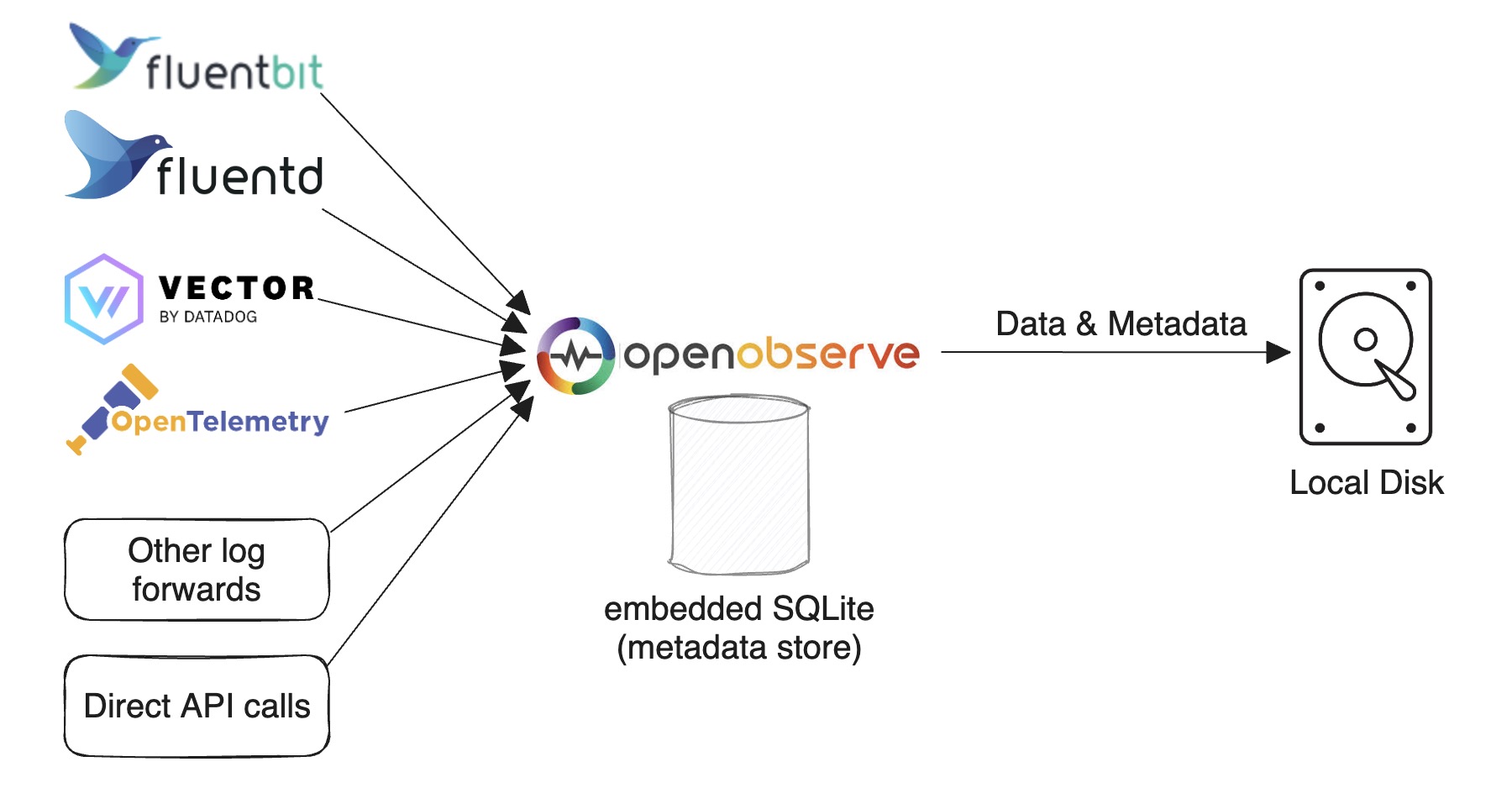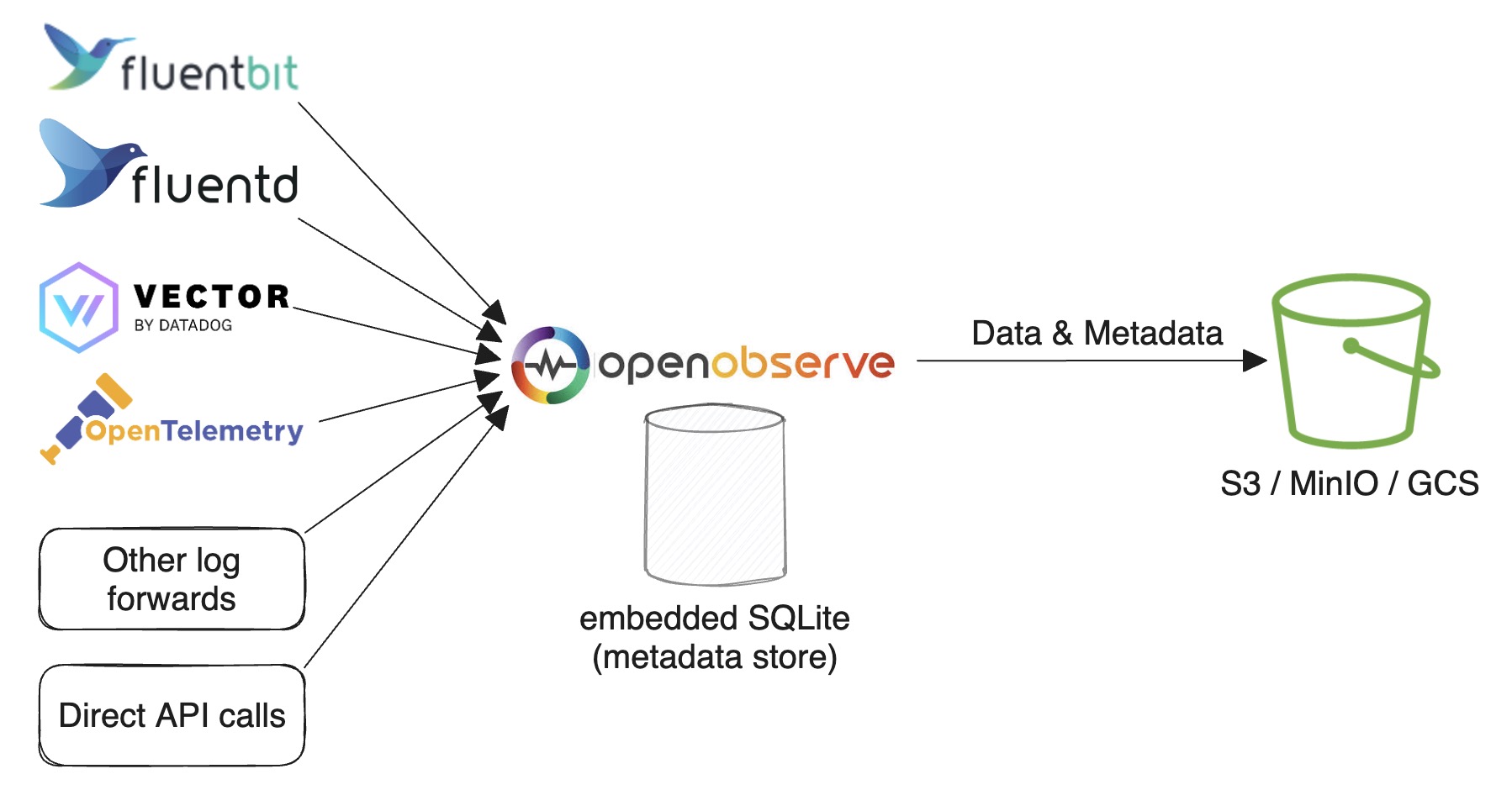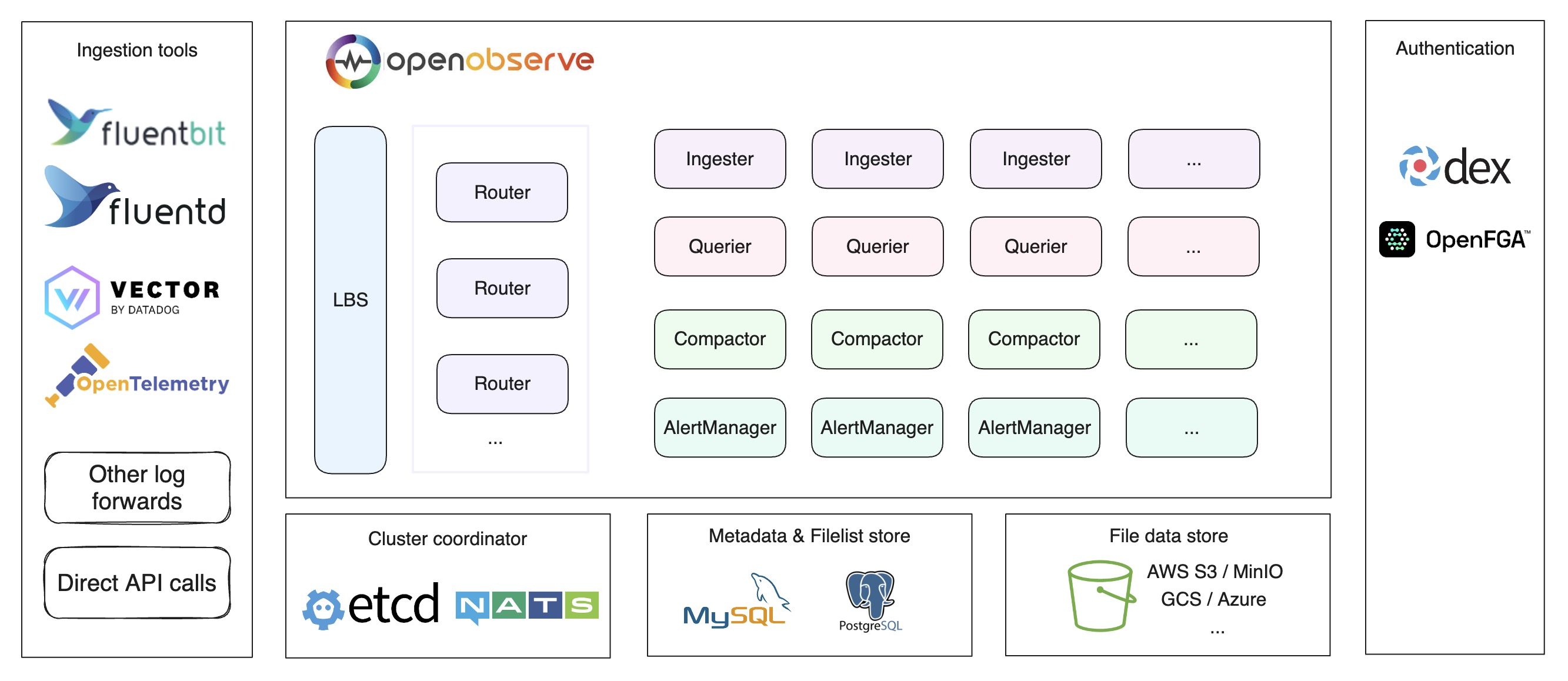Applicable to open source & enterprise version
Architecture and deployment modes
OpenObserve can be run in single node or in HA mode in a cluster.
Single Node
Please refer to quickstart for single node deployments.
SQLite and Local disk
Use this mode for light usage and testing or if HA is not a requirement for you. (You could still ingest and search over 2 TB on a single machine per day. On a mac M2 in our tests, you can ingest at ~31 MB/Second or 1.8 GB/Min or 2.6 TB/Day with default configuration). This is the default mode for running OpenObserve. Check Quickstart to find various ways to get this setup done.

SQLite and Object storage

High Availability (HA) mode
Local disk storage is not supported in HA mode. Please refer to HA Deployment for cluster mode deployment.

Router, Querier, Ingester, Compactor and AlertManager nodes both can be horizontally scaled to accommodate for higher traffic.
Etcd or NATS is used as cluster coordinator and store the nodes information. it also used for cluster events.
MySQL / PostgreSQL is used to store metadata like organization, users, functions, alert rules, stream schema and file list (a index of parquet files).
Object Storage (e.g. s3, minio, gcs, etc...) stores all the data of parquet files.
Durability
Astute users may notice that, on ingesters data is stored temporarily for batching before being sent to highly durable s3 (s3 is designed for 99.999999999% durability). There is only 1 copy of the data temporarily on the ingester and it may seem that this lends data to be vulnerable to loss in case of the disk failure before it is sent to s3. That is not entirely true though and there are ways to handle the lack of redundancy here. Most distributed systems that have been built in past were built in an era where storage was much less reliable than it is today and you would make 2-3 copies to ensure that you do not loose data.
In addition to that, in environments like AWS replicating data across multiple availability zones results in the penalty of cross AZ data transfer (2 cents per GB - 1 cent in each direction). In fact Amazon EBS volumes are already replicated within an AZ providing you with a highly durable storage. Standard GP3 EBS volumes provide 99.8% durability which is very high compared to regular disks. io2 volumes that OpenObserve team uses for its cloud service provides 99.999% durability which is even higher and at this level you don't really need to make multiple copies for durability.
For self hosted scenarios we recommend to use RAID-1 to ensure that you have redundancy at the disk level.
By choosing to build the system this way we are able to build a much more cost effective and simpler solution without having to manage ongoing replication of data across multiple nodes and the costs (money and complexity) associated with it.
Components
Ingester
Ingester is used to receive ingest request and convert data into parquet format and store it in object storage. They store data temporarily in WAL before transferring it to object storage.
The data ingestion flow is:
- receive data from HTTP / gRPC API request.
- parse data line by line.
- check if there are any functions (ingest functions) used to transform data, call each ingest function by the function order
- check for timestamp field, convert timestamp to microseconds; set current timestamp, if timestamp field isn't present in record.
- check stream schema to identify if schema needs evolution. Here if we find the schema need to be updated for addition of new fields or change of data type for existing fields, acquire
lockto update schema. - evaluate real time alerts if any defined for the stream.
-
write to WAL file by timestamp in hourly buckets and then convert records in a request to Arrow RecordBatch and write into Memtable.
- Create Memtable per
organization/stream_type, if data is being ingested forlogsonly there would be only one Memtable. - The WAL file and Metable are created in pair , one WAL file has one Memtable.WAL files are located at
data/wal/logs.
- Create Memtable per
-
As the Memtable size reaches
ZO_MAX_FILE_SIZE_IN_MEMORY=256MB or the WAL file reachedZO_MAX_FILE_SIZE_ON_DISK=128MB ,we will move the Memtable to Immutable and create a new Memtable & WAL file for writing data. - Every
ZO_MEM_PERSIST_INTERVAL=5seconds will dump Immutable to local disk. One Immutable will result in multiple parquet files as it may contain multiple streams and multiple partitions, the parquet files are located atdata/wal/files. - Every
ZO_FILE_PUSH_INTERVAL=10seconds we check local parquet files if any partition total size is aboveZO_MAX_FILE_SIZE_ON_DISK=128MB or any file has beenZO_MAX_FILE_RETENTION_TIME=600seconds ago all such small files in a partition will be merged into a big file (each big file will be maximumZO_COMPACT_MAX_FILE_SIZE=256MB) , which will be moved to object storage.
Ingester has three parts of data:
- data in Memtable
- data in Immutable
- parquet files in
walhaven't upload to object storage.
All of these need to be queried.
Querier
Querier is used to query data. Queriers nodes are fully stateless.
The data query flow is:
- receive search request using http API. The node receiving the query request becomes
LEADER querier for the query. Other queriers areWORKER queriers for query. LEADERparses and verifies SQL.LEADERfinds the data time range and gets file list from file list index.LEADERfetches querier nodes from cluster metadata.LEADERpartitions list of files to be queried by each querier. e.g. If 100 files needs to be queried and there are 5 querier nodes, each querier gets to query 20 filesLEADERworks on 20 files,WORKERSwork on 20 files each.LEADERcalls gRPC service running on eachWORKERquerier to dispatch search query to the querier node. Inter querier communication happens using gRPC.LEADERcollects, merges and sends the result back to the user.
Tips:
- The queriers will cache parquet files in memory by default. You can configure the amount of memory used by a querier for caching using environment variable
ZO_MEMORY_CACHE_MAX_SIZE. Default caching is done with 50% of the memory available to the particular querier. - In distributed environment each querier node will just cache a part of the data.
- We also have an option to enable caching latest parquet files in memory. The ingester will notify queriers to cache the file when ingester generates a new parquet file and uploads it to object storage.
Federated Search > Applicable to enterprise version
The federated search spans over multiple OpenObserve cluster:
- receive search request on one of the clusters, the node receiving the query request is called
LEADER cluster for the query. Other clusters areWORKER clusters for that query. LEADER clusterfinds all the clusters using super cluster metadata.LEADER clustercalls gRPC service on eachWORKER clusterwith same query payload as input.WORKER clusterexecute query as described above, one of the node becomes aLEADER querierin every cluster and call otherWORKER queriersin same cluster and results from all workers & leader are merged byLEADER cluster.LEADER clustercollects, merges and sends the result back to the user.
Compactor
Compactor merges small files into a big files to make searches more efficient. Compactor also enforces data retention policy, full stream deletion and updating of file list index.
Router
Router dispatches requests to ingester or querier. It also responds with the GUI in the browser. Router is a super simple proxy to send appropriate requests between ingester and querier.
AlertManager
AlertManager runs the Standard alert queries, report jobs and sends notification.

